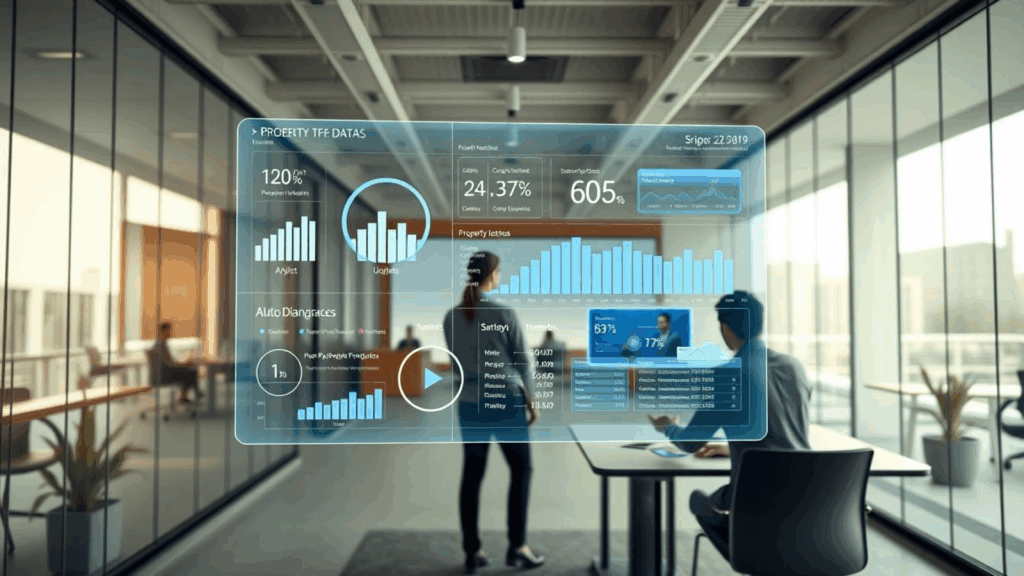Key performance indicators (KPIs) serve as critical instruments in enhancing property management efficiency. They provide immediate insights, pinpointing areas in dire need of attention. By zeroing in on maintenance efficiency metrics like repair speed and tenant satisfaction, property managers are better equipped. They can swiftly tackle problems, thereby safeguarding and potentially boosting revenue. Unlike lagging indicators such as profits, which only reveal results following the issue, these metrics advocate a preemptive stance.
Key Takeaways
- KPIs offer real-time performance measurement in property management.
- Focusing on repair speed helps proactively manage potential issues.
- Tenant satisfaction is a crucial maintenance efficiency metric.
- Proactive KPI tracking may lead to increased revenues.
- Real estate maintenance tracking can prevent issues before they impact profitability.
Understanding Key Performance Indicators in Property Maintenance
Key performance indicators (KPIs) are vital for the effective management of property maintenance. They enable property managers and technical asset managers to oversee maintenance activities in real-time. These metrics also allow for quick responses to emerging issues, enhancing operational efficiency.
Definition of KPIs in Property Maintenance
KPIs in property maintenance are measurable values that show how well management tasks are performed. These metrics, such as repair times and tenant turnover rates, offer insights into the effectiveness of maintenance efforts. For property managers, understanding these indicators is key to improving maintenance operations.
The Importance of KPIs in Real-Time Monitoring
In the fast-paced realm of property management, real-time monitoring is critical. It allows property managers to make quick, informed decisions. By observing key performance indicators closely, managers can prevent small issues from becoming major setbacks. This proactive approach helps in optimizing operations and meeting financial objectives.
Leading vs. Lagging Indicators
Grasping the distinction between leading and lagging indicators is key for superior property upkeep. It ensures high predictive maintenance KPIs. These measures enable asset managers and property managers to act swiftly. They prevent issues from worsening. Additionally, reflecting on such metrics fine-tunes future tactics.
Leading Indicators in Maintenance
Leading indicators act as early-alert mechanisms. They provide insights for timely preventive actions. For instance, metrics like adherence to inspection schedules and monitoring equipment condition help foresee problems. This foresight ensures consistent high standards across properties.
Adopting leading indicator practices allows for early problem detection. It reduces downtime, boosting efficiency.
Lagging Indicators Explained
In contrast, lagging indicators give a hindsight view of performance. They encompass metrics like the number of finalized tasks and expenses on repairs. These reflect outcomes after events happen. While crucial for assessing trends and results, lagging metrics are reactive.
Benefits of Leading Indicators
Focusing on leading indicators offers numerous advantages in maintenance. They facilitate proactive actions. These actions, driven by predictive maintenance metrics, improve tenant satisfaction and retention. Moreover, they promote strategic decisions, mitigate risks, and enhance resource use. Ultimately, these factors contribute to greater operational success and profitability.
- Helps forecast maintenance issues
- Boosts tenant satisfaction and retention rates
- Facilitates timely and informed decision-making
| Indicators | Data Insight | Purpose |
|---|---|---|
| Leading Indicators | Scheduled Inspections, Equipment Conditions | Proactive Interventions |
| Lagging Indicators | Completed Work Orders, Repair Costs | Retrospective Analysis |
Repair Speed and Its Impact on Tenant Satisfaction
Repair speed is a key maintenance KPI, significantly affecting tenant satisfaction. Swift resolution of maintenance requests can enhance tenant retention and improve property performance. Property managers must monitor repair speed closely. This ensures timely repairs, leading to more satisfied tenants and fewer complaints.
Measuring Time to Resolve Maintenance Requests
It’s vital to track how long resolving maintenance requests takes. This period extends from when a tenant makes a request to its full resolution. Analyzing this data highlights inefficiencies and resource allocation problems. Consequently, it paves the way for ongoing improvements in repair processes.
Relationship Between Repair Speed and Tenant Retention
There’s a direct correlation between repair speed KPI and tenant retention. Swiftly resolved maintenance requests boost tenant satisfaction. Conversely, delays can lead to dissatisfaction and increased turnover. Thus, emphasizing repair speed in maintenance KPIs is essential for maintaining high retention rates and ensuring property success.
Preventive Maintenance Completion Rate
The Preventive Maintenance Completion Rate measures the percentage of planned maintenance tasks finished. It’s crucial for keeping property in good shape and preventing unforeseen breakdowns.
Importance of Preventive Maintenance
For property and technical asset managers, the efficacy of preventive maintenance is key. It allows for early identification of possible issues. This keeps assets performing at their best. A high preventive maintenance rate KPI signifies proactive management. It helps avoid sudden repairs and maintains asset value over time.
Steps to Improve Completion Rates
To boost preventive maintenance completion rates, a few strategic steps are necessary. Start by implementing a thorough KPI system for maintenance management. This improves the planning and monitoring of maintenance activities. Then, ensure all maintenance activities are well documented. Regular review meetings should also be held. This helps identify and remove bottlenecks, improving resource use.
Furthermore, continuous training for the maintenance team is imperative. It makes sure they stay informed about the latest maintenance methods and knowledge. This boosts preventive maintenance effectiveness.
| Strategy | Implementation | Benefits |
|---|---|---|
| Comprehensive KPI System | Implement detailed tracking metrics | Improves scheduling and task monitoring |
| Detailed Documentation | Regular reviews and updates | Identifies bottlenecks for better efficiency |
| Staff Training | Continuous education programs | Ensures up-to-date maintenance knowledge |
Emphasizing the preventive maintenance rate KPI and employing these strategies significantly boosts maintenance efficiency. This comprehensive preventive maintenance approach ensures properties stay in prime condition. It reduces the cost of emergency repairs and extends asset lifespans.
Monitoring Maintenance Cost Per Unit
Effectively monitoring the maintenance cost per unit KPI is key to understanding your property management’s financial health. This vital metric aids in tracking maintenance KPIs, ensuring expenses are kept in check. Consequently, this leads to enhanced budget management.
Calculating Maintenance Costs
Accounting for every cost related to property maintenance is crucial. This encompasses labor, materials, and additional overhead. By keeping precise records, managers gain a clear insight into the costs of maintaining each unit.
- Direct labor costs
- Materials and supplies
- Overhead and administrative expenses
Optimizing Budgets and Controlling Expenses
Analyzing the maintenance cost per unit KPI regularly sheds light on potential for expense optimization. Through thorough KPI analysis, it’s possible to spot ways to cut costs and minimize waste. This strengthens the process of optimizing maintenance budgets, letting property managers allocate resources more efficiently. As a result, high standards are upheld while controlling maintenance expenses.
By leaning into data-driven strategies and diligent tracking of maintenance KPIs, managers can significantly control expenses. This boosts operational efficiency, aligning with a firm’s financial aspirations. Ultimately, it secures the property management’s success and longevity.
Measuring Tenant Satisfaction
Tenant satisfaction is key in enhancing property management services. Through various strategies, property managers can boost tenants’ living experiences.
Methods to Collect Tenant Feedback
For precise satisfaction measurement, effective tenant feedback collection is paramount. Widely used methods include:
- Surveys: Distribute digital or paper surveys to gather opinions on maintenance services.
- Interviews: Conduct face-to-face or phone interviews for detailed feedback.
- Online Reviews: Monitor reviews on online platforms to understand tenant sentiments.
The Role of Tenant Satisfaction in KPIs
Tenant satisfaction KPIs offer insights into maintenance service performance. They enable property managers to:
- Identify strengths and weaknesses in maintenance operations.
- Track improvements via trends over time.
- Establish benchmarks and objectives for enhancing service.
Improving Maintenance Services Through Feedback
By leveraging maintenance dashboard metrics and analyzing feedback, targeted improvements in maintenance service can be made. Key steps are:
- Analyzing negative feedback to identify specific issues.
- Implementing changes inspired by tenant suggestions.
- Continuous monitoring of updates for effective solutions.
Through ongoing tenant feedback collection and smart use of dashboard metrics, higher tenant satisfaction KPIs are achievable. This fosters a beneficial relationship between tenants and property managers.
Work Order Backlog Analysis
The work order backlog KPI is essential for technical property and asset managers. It helps them track outstanding maintenance tasks. By monitoring this KPI, managers can spot inefficiencies. Then, they can adjust maintenance resource allocation to complete tasks on time.
Identifying and Addressing Resource Issues
Allocating maintenance resources correctly is vital for managing work order backlogs. A significant backlog often means current resources are not enough. Managers must assess if the issue is inadequate staffing, insufficient tools, or process bottlenecks. Proper allocation and outsourcing can greatly improve maintenance operations.
Impact of High Backlog on Employee Morale
A high backlog negatively impacts maintenance staff. Overloading employees with tasks can lead to burnout and lower job satisfaction. Monitoring the impact of backlog on maintenance staff is crucial. Analyzing and adjusting based on the KPI can manage employee stress and keep productivity and morale high.
Benefits of a Maintenance Dashboard
A maintenance dashboard inside property management systems has many advantages. It benefits both technical property managers and asset managers. It offers a real-time, centralized view of crucial maintenance KPI metrics. Managers can track, assess, and improve their maintenance operations efficiently.
Real-Time KPI Monitoring
A key advantage of a maintenance dashboard is real-time KPI monitoring. This lets property managers quickly identify areas needing attention. It aids in making prompt, informed choices. Real-time KPI tracking is essential for upholding high property maintenance standards, improving tenant satisfaction and retention.
Streamlining Maintenance Management
Using a maintenance dashboard simplifies property upkeep by presenting important data accessibly. It allows managers to easily understand metrics, like repair speed or preventive maintenance rates. They can then better allocate resources. Streamlining maintenance with a dashboard not only boosts efficiency but ensures a proactive stance on issues, resulting in smoother operations and higher satisfaction.
FAQ
What are KPIs in property maintenance?
In property maintenance, KPIs are metrics that gauge aspects like repair times and costs, and tenant satisfaction. They help managers tackle issues early, ensuring profitability and efficiency.
Why is real-time monitoring of maintenance KPIs important?
Real-time KPI monitoring is key. It allows for quick decision-making and issue prevention. By tracking these metrics, managers can boost operations, keep tenants happy, and improve financial outcomes.
What’s the difference between leading and lagging indicators in maintenance?
Leading indicators forecast potential issues, similar to a car’s speedometer, allowing for preventive action. Lagging indicators, like a speeding ticket, show results after a problem occurs. Focusing on leading indicators can prevent issues and increase maintenance efficiency.
How does repair speed affect tenant satisfaction?
Quick repairs significantly influence tenant satisfaction. Timely maintenance leads to greater happiness, retention, and positive feedback. Streamlining repair speed is critical for sustaining healthy tenant relationships and minimizing turnover.
What is the Preventive Maintenance Completion Rate, and why is it important?
This KPI measures on-time completion of scheduled preventive tasks. It’s crucial for maintaining property conditions, preventing failure, and lowering emergency costs, thereby preserving asset value.
How do you monitor the maintenance cost per unit?
To monitor these costs, one tracks the average spend needed for each unit’s upkeep. This analysis aids in budget management, cost control, and operational income optimization.
What methods are used to collect tenant feedback?
Collecting feedback involves surveys, interviews, and reviews. These approaches offer insights into tenant satisfaction and service quality, guiding operational improvements.
How does a high work order backlog affect maintenance staff?
An extensive backlog can demoralize staff, leaving them overwhelmed by tasks. Analyzing this KPI helps streamline work distribution, reduce stress, and boost staff morale.
What are the benefits of using a maintenance dashboard?
Maintenance dashboards provide a unified, instant overview of KPIs, simplifying the tracking and management of maintenance activities. They facilitate quick data analysis, allowing for agile maintenance adjustments.






